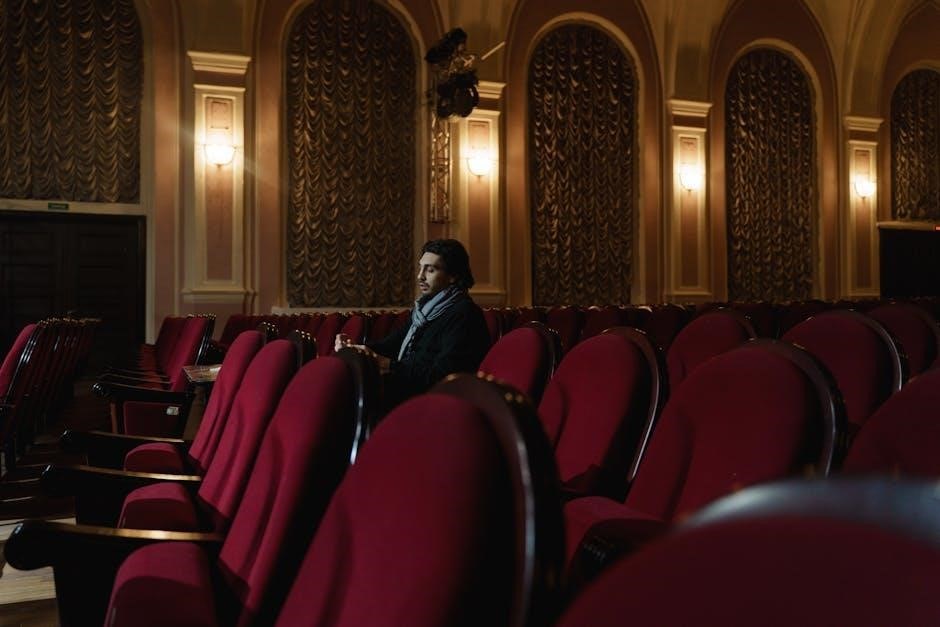
waiting for godot play pdf
Samuel Beckett’s Waiting for Godot is a seminal absurdist tragicomedy. The play’s PDF version is widely available‚ offering the original French text‚ English translation‚ and detailed stage directions for study.
1.1 Overview of the Play’s Significance
Waiting for Godot is a groundbreaking tragicomedy by Samuel Beckett‚ widely regarded as one of the most enigmatic plays of modern literature. It revolutionized 20th-century theater‚ establishing the Theater of the Absurd. The play explores existential themes‚ such as the futility of human existence and the meaning of waiting‚ through repetitive dialogue and purposeless situations. Its significance lies in its ability to provoke thought and reinterpretation‚ making it a cornerstone of absurdist drama and a timeless work of literary art.
1.2 Availability of the Play in PDF Format
The play Waiting for Godot is widely available in PDF format‚ making it easily accessible for readers worldwide. Official publishers and online retailers like Amazon and Google Books offer downloadable versions‚ often bundled with study guides or summaries. Additionally‚ many academic databases and library platforms provide free or subscription-based access. While some websites offer free PDF downloads‚ users should ensure they are using legal and reliable sources to avoid unauthorized versions.

Background of the Play
Waiting for Godot was written by Samuel Beckett between 1948 and 1949‚ drawing inspiration from existentialist philosophy and post-WWII disillusionment‚ revolutionizing modern theater.
2.1 Historical Context and Inspiration
Written in the late 1940s‚ Waiting for Godot emerged from a post-WWII world grappling with existential crises. Beckett drew inspiration from personal experiences‚ including his time in France during the war and his association with the French Resistance. The play reflects the absurdity and uncertainty of life‚ influenced by existentialist philosophy and the Theater of the Absurd movement. Beckett’s unique style‚ blending humor with despair‚ was revolutionary‚ setting the play apart as a seminal work in modern theater history.
2.2 Samuel Beckett’s Writing Style
Samuel Beckett’s writing style in Waiting for Godot is characterized by minimalism‚ absurdity‚ and a unique blend of humor and existential despair. His use of repetitive dialogue‚ simple language‚ and fragmented narrative reflects the play’s themes of uncertainty and meaninglessness. Beckett’s avoidance of conventional plot structures and his focus on circular‚ non-linear storytelling emphasize the absurdity of human existence. This distinctive style has made the play a cornerstone of the Theater of the Absurd movement‚ leaving audiences and readers with a profound sense of ambiguity and introspection.
2.3 The Original French Version: “En attendant Godot”
“En attendant Godot” is the original French version of Samuel Beckett’s iconic play‚ written between 1948 and 1949. Beckett‚ an Irish author‚ chose to write in French‚ which he believed offered him greater creative freedom and linguistic precision. The play was first published in French in 1952 and later translated into English by Beckett himself. This version remains significant‚ as it reflects Beckett’s intent and stylistic preferences‚ showcasing his mastery of language and existential themes. Its publication marked a turning point in modern theater.

Plot Summary
“Waiting for Godot” revolves around Vladimir and Estragon‚ two men endlessly waiting for someone named Godot. Their interactions‚ Pozzo’s arrival‚ and a boy’s message highlight the absurdity of their existence.
3.1 Act 1: The Initial Encounter
The play opens on a desolate landscape with a single tree. Vladimir and Estragon‚ two vagrants‚ await Godot. Their dialogue‚ filled with uncertainty and repetition‚ establishes their dynamic. Estragon struggles with his boots‚ while Vladimir tries to recall their purpose. They discuss hanging themselves but lack the courage. Pozzo and Lucky enter‚ disrupting the monotony. Pozzo’s authoritarian demeanor contrasts with Lucky’s submissiveness. The act ends with Vladimir and Estragon deciding to wait again‚ emphasizing their existential limbo.
3.2 Act 2: The Continuation of Waiting
Act 2 mirrors the structure of Act 1‚ with Vladimir and Estragon still waiting for Godot. Pozzo and Lucky reappear‚ but Pozzo is now blind‚ and Lucky is mute. The boy returns to inform them Godot will not come that night. The act deepens the themes of absurdity and existential despair‚ as the characters’ struggles and interactions highlight the futility of their waiting. The repetition underscores the cyclical nature of their existence‚ reinforcing the play’s exploration of meaninglessness and the human condition.
3.3 Key Events and Character Interactions
Key events include Vladimir and Estragon’s initial meeting‚ their interactions with Pozzo and Lucky‚ and the recurring visits from the boy. The characters’ dialogue reveals their dependency on each other‚ with Vladimir often taking a caretaker role. Pozzo’s transformation from a tyrant to a blind man highlights the play’s exploration of power dynamics. Lucky’s silence in Act 2 contrasts with his earlier monologue‚ symbolizing the loss of meaning. These interactions underscore the futility of waiting and the characters’ existential struggles.

Main Characters
Vladimir and Estragon await Godot‚ showcasing their bond and existential plight. Pozzo and Lucky embody master-slave dynamics‚ while the boy serves as a mysterious messenger‚ deepening the play’s enigma.
4.1 Vladimir (Didi)
Vladimir‚ often called Didi‚ is one of the two central figures in the play. He is typically seen as the more optimistic and philosophical of the duo‚ often engaging in deeper existential musings. His relationship with Estragon (Gogo) is complex‚ marked by mutual dependence and a blend of hope and despair. Vladimir’s character embodies the human condition’s fragility and resilience‚ as he clings to the idea of waiting for Godot‚ symbolizing the search for meaning in an uncertain world. His dialogue often reflects a mix of frustration and determination‚ highlighting the absurdity of their situation while maintaining a glimmer of hope.
4.2 Estragon (Gogo)
Estragon‚ often referred to as Gogo‚ is the more pragmatic and pessimistic counterpart to Vladimir. He is physically burdened‚ often struggling with his boots‚ symbolizing his daily suffering. Estragon’s character is marked by his emotional volatility‚ oscillating between frustration and resignation. His relationship with Vladimir is one of dependency‚ yet their interactions are fraught with tension. Estragon’s focus on immediate needs contrasts with Vladimir’s philosophical musings‚ making him a grounding force in their absurd existence. His resilience‚ despite constant disappointment‚ underscores the human capacity to endure.
4.3 Pozzo and Lucky
Pozzo‚ a self-proclaimed master‚ and Lucky‚ his enslaved companion‚ form a contrasting duo. Pozzo exudes arrogance and control‚ while Lucky is subjugated and speechless‚ except for a nonsensical monologue. Their relationship highlights themes of power dynamics and exploitation. Pozzo’s blindness in Act 2 symbolizes the loss of control and understanding‚ mirroring the play’s existential themes. Lucky’s presence underscores the absurdity of human interaction‚ as his only speech is a jumbled‚ meaningless rant‚ reflecting the breakdown of communication and meaning in a chaotic world.
4.4 The Boy
The Boy is a minor yet enigmatic character who appears twice‚ delivering cryptic messages about Godot. His presence adds to the play’s ambiguity‚ as his statements are often vague and open to interpretation. The Boy’s role serves as a catalyst for Vladimir and Estragon’s continued waiting‚ reinforcing the cycle of expectation and uncertainty. His character symbolizes innocence and the unknown‚ while his limited dialogue underscores the themes of communication and the futility of seeking clear answers in an absurd world.
Themes and Symbolism
Existentialism‚ absurdity‚ and the meaning of waiting dominate the play. The tree symbolizes hope and futility‚ while the circular dialogue reflects the characters’ endless‚ unfulfilled expectations.
5.1 Existentialism and the Absurd
Existentialism and the absurd are central themes in “Waiting for Godot.” The play reflects existentialist philosophy through characters’ meaningless actions and endless waiting.
The absurdity lies in the futility of their existence‚ as they seek purpose without clarity. Beckett explores the human condition‚ emphasizing uncertainty and the search for meaning in a seemingly indifferent world. This theme resonates deeply‚ making the play a cornerstone of existentialist literature and absurdist theater.
5.2 The Meaning of Waiting
The concept of waiting in “Waiting for Godot” is deeply symbolic‚ representing the human condition’s uncertainty and ambiguity. Vladimir and Estragon’s endless wait for Godot embodies existential limbo‚ where meaning is elusive.
The act of waiting becomes a metaphor for life’s inherent uncertainty‚ as the characters cycle through repetitive actions without resolution. This perpetual anticipation reflects the absurdity of seeking definitive answers in an indifferent universe‚ leaving audiences to ponder the significance of their own waiting.
5.3 The Tree as a Symbol
The tree in “Waiting for Godot” is a powerful symbol‚ representing the bareness and desolation of existence. Its leafless state in Act 1 mirrors the characters’ emotional emptiness‚ while the appearance of leaves in Act 2 hints at minimal change without real fulfillment. The tree‚ like the characters‚ endures but offers no shade or comfort‚ symbolizing life’s futility and the search for meaning in a seemingly indifferent world. Its presence underscores the play’s themes of existential despair and the absurd.

Theater of the Absurd
Theater of the Absurd explores existential themes and absurdity through illogical‚ unconventional narratives. Samuel Beckett’s “Waiting for Godot” exemplifies this genre‚ emphasizing meaninglessness and human futility.
6.1 Definition and Key Features
Theater of the Absurd is a dramatic genre emphasizing absurdity and illogicality in human existence. It features open-ended narratives‚ fragmented dialogue‚ and isolation themes. Plays often reject traditional structures‚ embracing existential ambiguity; Comedy and absurdity highlight life’s meaninglessness. Waiting for Godot exemplifies this‚ blending dark humor with philosophical inquiry‚ challenging audiences to interpret its enigmatic scenes and characters.
6.2 “Waiting for Godot” as a Seminal Work
Waiting for Godot revolutionized theater by embodying the essence of the Absurd. Its open-ended narrative‚ lack of traditional plot‚ and repetitive dialogue challenged conventional storytelling. The play’s exploration of existential themes‚ such as meaningless waiting and the search for purpose‚ resonated deeply. It influenced countless playwrights‚ solidifying its status as a landmark of modern theater. Its enduring relevance lies in its universal questioning of human existence‚ making it a cornerstone of absurdist drama.

Stage Directions and Performance
The play’s stage directions emphasize a minimalist set with a single tree and road‚ symbolizing existential ambiguity. Visual simplicity highlights the absurdity of waiting‚ while lighting and the tree’s transformation reflect time’s passage‚ enhancing the haunting atmosphere and themes of futility.
7.1 Setting and Visual Elements
The setting of Waiting for Godot is minimalist and symbolic‚ reflecting the play’s existential themes. The stage features a single tree‚ a stone‚ and a distant road‚ emphasizing isolation and ambiguity. The sparse visual elements create a stark‚ haunting atmosphere‚ mirroring the characters’ existential despair. The tree‚ often bare or with leaves‚ symbolizes hope and desolation‚ while the stone serves as a makeshift bench‚ underscoring the characters’ entrapment. Lighting is dim and neutral‚ reinforcing the play’s absurdity and timelessness.
The visual simplicity forces audience focus on dialogue and emotions‚ rather than elaborate scenery. Costumes are equally plain‚ with characters dressed in tattered‚ nondescript clothing‚ highlighting their poverty and existential struggle. These visual choices enhance the play’s universality‚ making it relatable across cultures and interpretations.
7.2 Notable Stage Productions
The original 1953 Paris production‚ directed by Roger Blin‚ was groundbreaking. The 1955 London debut‚ despite initial controversy‚ established the play’s reputation. In 2013‚ a Broadway production featuring Ian McKellen and Patrick Stewart ran successfully for months. These stagings showcased the play’s versatility and enduring appeal‚ solidifying its place as a cultural icon. Each production highlighted the absurdity and existential themes‚ ensuring “Waiting for Godot” remains a landmark in modern theater.

Critical Analysis
Critics explore the existential themes and absurdity in “Waiting for Godot‚” debating Godot’s identity as a metaphor for the divine‚ fate‚ or the unknown‚ reflecting human existential struggles.
8.1 Interpretations of Godot’s Identity
The identity of Godot remains one of the most debated aspects of the play‚ with interpretations ranging from religious to philosophical. Some view Godot as a symbol of divine presence or a higher power‚ while others see him as a representation of existential waiting and the unknown. Beckett’s refusal to clarify Godot’s identity has led to theories linking him to everything from a metaphysical concept to a satirical critique of societal expectations. The ambiguity surrounding Godot underscores the play’s themes of uncertainty and the search for meaning.
8.2 Psychological and Philosophical Insights
The play delves into profound psychological and philosophical themes‚ exploring existential despair‚ absurdity‚ and the human condition. Vladimir and Estragon’s futile waiting symbolizes the meaningless search for purpose in life. Their cyclical conversations and repetitive actions reflect the absurdity of human existence. The play challenges traditional notions of purpose and destiny‚ inviting audiences to ponder the meaninglessness of life and the inevitability of uncertainty. Beckett’s work resonates with existentialist philosophy‚ emphasizing individual freedom and the absurd.

Downloads and Resources
Access Waiting for Godot in PDF format for free or purchase from reputable sources like online libraries‚ educational websites‚ or e-book platforms. Ensure downloads are legal and virus-free for safe access to the play and supplementary study materials.
Find detailed study guides‚ summaries‚ and critical analyses to enhance understanding of the play’s themes‚ characters‚ and historical context. These resources are available on academic and literary websites.
9.1 Free PDF Downloads of the Play
Accessing Waiting for Godot in PDF format is convenient for readers worldwide. Many websites offer free downloads‚ though availability depends on regional copyright laws. Platforms like Google Books and Internet Archive provide digitized versions‚ often free for public access. Additionally‚ educational institutions and theater groups may share PDFs for study purposes. Always verify the source’s legitimacy to ensure the download is legal and complete. Libraries also offer e-book versions‚ making it easy to access the play digitally without cost.
9.2 Study Guides and Summaries
Study guides and summaries for Waiting for Godot provide in-depth analyses of themes‚ characters‚ and symbols‚ aiding readers in understanding the play’s complexities. These resources often include plot breakdowns‚ critical essays‚ and discussion questions‚ making them invaluable for students and enthusiasts. Many websites offer free downloadable guides‚ while others are available as PDFs through academic platforms. These materials help unpack the existential themes and absurd elements‚ offering insights into Beckett’s unique writing style and the play’s enduring relevance.

Cultural Impact
The play’s influence extends beyond theater‚ shaping absurdist literature and inspiring artists globally‚ while being a cornerstone in academic curricula‚ reflecting its enduring cultural significance.
10.1 Influence on Modern Theater
Since its debut‚ Waiting for Godot has profoundly shaped modern theater‚ becoming a cornerstone of absurdist drama. Its exploration of existential themes and unconventional dialogue inspired playwrights like Harold Pinter and Edward Albee. The play’s minimalist staging and focus on the absurd have influenced countless productions‚ redefining audience expectations. Beckett’s work challenged traditional narrative structures‚ encouraging experimentation and pushing the boundaries of theatrical expression. Its enduring influence ensures its relevance in contemporary theater‚ making it a timeless masterpiece of 20th-century drama.
10.2 Adaptations and Parodies
Adaptations of Waiting for Godot have spanned various mediums‚ including films‚ animations‚ and even musicals. A notable example is the 2001 animated short film‚ which reimagined the play in a stark‚ visual style. Additionally‚ the play has inspired countless parodies‚ with comedians and writers drawing on its absurdist themes. For instance‚ South Park parodied the play in an episode titled “The List‚” highlighting its existential humor. These adaptations underscore the play’s universal appeal and its ability to transcend traditional theater‚ making it a timeless cultural reference point.
“Waiting for Godot” remains a seminal work in modern theater‚ exploring existential themes and the absurd. Its timeless relevance continues to captivate audiences‚ offering profound insights into human existence. The play’s availability in PDF format ensures its accessibility for contemporary readers and scholars‚ solidifying its enduring legacy in literary and theatrical discourse.
11.1 Legacy of “Waiting for Godot”
“Waiting for Godot” has revolutionized modern theater‚ leaving an indelible mark on dramatic literature. Its exploration of existential themes and absurdity continues to resonate‚ inspiring countless adaptations and interpretations. As a cornerstone of the Theater of the Absurd‚ it has influenced playwrights worldwide‚ shaping contemporary drama. Its timeless themes of hope‚ despair‚ and the meaning of existence ensure its relevance‚ making it a seminal work in world literature. Its legacy endures‚ remaining a vital exploration of humanity’s existential condition.
11.2 Relevance in Contemporary Context
Despite being written decades ago‚ Waiting for Godot remains strikingly relevant today. Its exploration of existential uncertainty‚ the absurdity of life‚ and the human condition continues to resonate with modern audiences. The play’s themes of waiting‚ uncertainty‚ and the search for meaning align with contemporary issues like climate change‚ political polarization‚ and technological overwhelm. Its influence is evident in modern art‚ theater‚ and philosophy‚ proving its timeless appeal and universal significance in understanding the complexities of human existence.

References and Further Reading
Explore academic articles‚ essays‚ and PDF resources for deeper analysis of Waiting for Godot. Study guides and scholarly critiques offer insights into themes and interpretations.
- Academic articles on existentialism and absurdism.
- PDF downloads of critical essays and analyses.
- Study guides for educational purposes.
12.1 Academic Articles and Essays
Academic articles and essays on Waiting for Godot offer in-depth analyses of its themes‚ characters‚ and philosophical underpinnings. Scholars explore the play’s existentialist themes‚ the absurdity of human existence‚ and the enigmatic figure of Godot. Essays often examine Beckett’s use of language‚ the play’s structure‚ and its impact on modern theater. Many academic works also delve into the psychological dimensions of the characters‚ such as Vladimir and Estragon’s relationship‚ and the symbolism of the tree and the boots. These resources provide valuable insights for students and researchers.
12.2 PDF Resources for In-Depth Analysis
For scholars and enthusiasts seeking deeper insights‚ various PDF resources offer comprehensive analyses of Waiting for Godot. These include academic essays‚ critical interpretations‚ and annotated scripts that explore themes‚ characters‚ and philosophical underpinnings. Many university libraries and literary websites provide downloadable PDFs of conference papers and book chapters dedicated to Beckett’s masterpiece. Additionally‚ resources like The Beckett Journal and Samuel Beckett Studies publish in-depth PDF analyses‚ making them invaluable for researchers. These materials often delve into existentialism‚ absurdism‚ and the play’s enduring relevance.

antibiotic table pdf
You May Also Like

m.i.n.i. neuropsychiatric interview pdf
June 4, 2024
makkar ielts speaking pdf 2024
July 31, 2024
